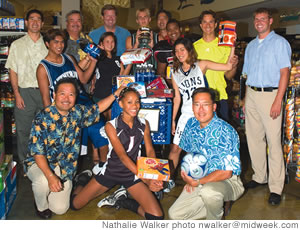For the team
With ‘Shop And Score’ beginning Wednesday, scholar-athletes from schools that benefitted last year urge MidWeek readers to shop and declare your favorite school at Times Supermarkets.

By .(JavaScript must be enabled to view this email address)
E-mail this story | Print this page | Archive | RSS |
 Del.icio.us
Del.icio.us
|
Kerry Patton, a sophomore football player at Radford High School, pounds his chest saying, “This is all you need” when asked if there was anything lacking from his school’s athletic department.
While his coaches may appreciate his testament to the importance of heart, they no doubt could add a litany of items that are currently beyond their financial means. Simple things like uniforms, helmets, transportation, first aid and safety equipment.
They are not alone, nor is this a new problem. Public schools throughout the state and across the nation struggle to find a balance between paying for activities that provide tremendous benefits for students while at the same time making sure there is enough money to maintain their primary goal of education.
Fundraisers help out where they can, but it’s not an endless stream of revenue.
“We try to limit the number of fundraisers because we can’t continue to go back to the families over and over again for money,” says Kelly Johnstone, the assistant athletic director at Radford.
And that’s a shame because Johnstone feels the benefits of extra-curricular activities are widespread.
“I think it gets kids involved in positive peer groups, being a part of the community and feeling that connectiveness to the school and to a group. I think that’s really key for kids today.”
Though it might sound clichéd, success on the athletic field can be a precursor to success later in life. U.S. News and World Report recently reported on a study by professors at Brigham Young University and Westchester University of Pennsylvania, that girls who play sports in high school were 73 percent more likely to earn a bachelor’s degree within six years of graduating high school than those who did not participate.
That athletics is beneficial to academics should not be much of a surprise since high school sports are a perform-to-play operation. Either do the work and get the grades or you don’t play. It’s pretty simple. It’s also why students have their grades checked every two weeks; to be sure there are no surprises. And while balancing both can mean turning off the Playstation on occasion, it’s nothing they can’t handle.
“School comes first,” says Kaeli Patton, a volleyball player at Radford. “You just have to put in the necessary time.”
“Everybody should be able to handle both. It’s just an excuse if you say you can’t,” says Kerry, sounding like the son of a coach that he is. In fact, athletics is the Patton family business. Father Sidne, coaches football and track at Radford while mother Elizabeth coaches cross country and track for the Rams. Older brother Kenny was a cornerback for the University of Hawaii who had a fling with the Oakland Raiders.
Another problem facing parents and school administrators is trying to find a way to get kids off the couch. Though athletics is often highlighted for its ability to help students make friends, gain confidence and learn the value of teamwork, it can also have another long-lasting effect - it can set them on the road to a lifetime of good health.
As cable television, the Internet and video games compete with more viperous activities as forms of entertainment, Americans are becoming more sedentary and less healthy. Time magazine reported that two-thirds of the U.S. population was either overweight or obese. Sadly, these numbers include children. The Center for the Advancement of Health reports that only 28 percent of chil-
Page 1 of 2 pages for this story 1 2 >
E-mail this story | Print this page | Comments (0) | Archive | RSS
Most Recent Comment(s):








